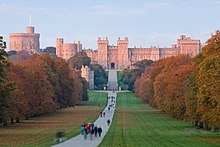Etymology
The Norman "White Tower", the keep of the Tower of London, exemplifies all uses of a castle including city defence, a residence, and a place of refuge in times of crisis.
The word castle is derived from the Latin word castellum which is a diminutive of the word castrum, meaning "fortified place". The Old English castel, Old French castel or chastel, French château, Spanish castillo, Italian castello, and a number of words in other languages also derive from castellum. The word castle was introduced into English shortly before the Norman Conquest to denote this type of building, which was then new to England.
Defining characteristics
In its simplest terms, the definition of a castle accepted amongst academics is "a private fortified residence". This contrasts with earlier fortifications, such as Anglo Saxon burbs and walled cities such as Constantinople and Antioch in the Middle East; castles were not communal defenses but were built and owned by the local feudal lords, either for themselves or for their monarch. Feudalism was the link between a lord and his vassal where, in return for military service, the lord would grant the vassal land and expect loyalty. In the late 20th century, there was a trend to refine the definition of a castle by including the criterion of feudal ownership, thus tying castles to the medieval period, however, this does not necessarily reflect the terminology used in the medieval period. During the First Crusade (1096–1099) the Frankish armies encountered walled settlements and forts that they indiscriminately referred to as castles, but which would not be considered as such under the modern definition.
Windsor Castle in England was founded as a fortification during the Norman Conquest and today is one of the principal official residences of Queen Elizabeth II.
Castles served a range of purposes, the most important of which were military, administrative, and domestic. As well as defensive structures, castles were also offensive tools which could be used as a base of operations in enemy territory. Castles were established by Norman invaders of England for both defensive purposes and to pacify the country's inhabitants.[6] As William the Conqueror advanced through England he fortified key positions to secure the land he had taken. Between 1066 and 1087 he established 36 castles such as Warwick Castle, which he used to guard against rebellion in the English Midlands.
Towards the end of the Middle Ages, castles tended to lose their military significance due to the advent of powerful cannons and permanent artillery fortifications; as a result, castles became more important as residences and statements of power. A castle could act as a stronghold and prison but was also a place where a knight or lord could entertain his peers. Over time the aesthetics of the design became more important, as the castle's appearance and size began to reflect the prestige and power of its occupant. Comfortable homes were often fashioned within their fortified walls. Although castles still provided protection from low levels of violence in later periods, eventually they were succeeded by country houses as high status residences.
Terminology
Castle is sometimes used as a catch-all term for all kinds of fortifications, and as a result has been misapplied in the technical sense. An example of this is Maiden Castle which, despite the name, is an Iron Age hill fort, which had a very different origin and purpose.
Although "castle" has not become a generic term for a manor house (like château in French and Schloss in German) many manor houses contain "castle" in their name while having few if any of the architectural characteristics, usually as their owners liked to maintain a link to the past and felt the term "castle" was a masculine expression of their power. In scholarship the castle, as defined above, is generally accepted as a coherent concept, originating in Europe and later spreading to parts of the Middle East, where they were introduced by European Crusaders. This coherent group shared a common origin, dealt with a particular mode of warfare, and exchanged influences.
In different areas of the world, analogous structures shared features of fortification and other defining characteristics associated with the concept of a castle, though they originated in different periods and circumstances and experienced differing evolutions and influences. For example shiro in Japan, described as castles by historian Stephen Turnbull, underwent "a completely different developmental history, were built in a completely different way and were designed to withstand attacks of a completely different nature".[16] While European castles built from the late 12th and early 13th century onwards were generally stone, shiro were predominantly timber buildings into the 16th century.
CASTLE VIDEO
https://www.youtube.com/watch?v=JGbPShUpjpg

